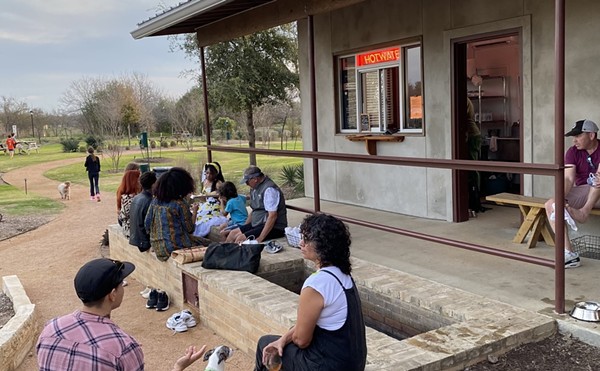|
Chef Boy Ari |
Dear Chef Boy Ari:
Ever since I was a kid, I’ve loved baked mac and cheese: melted block cheese poured over cooked pasta shells, covered in crumpled potato chips and baked until the mess is congealed into a single glob. I’ve always made it with Velveeta, just like dear madre did. I realize Velveeta is more like plastic than cheese, but I haven’t been able to engineer a substitute that melts as neatly and congeals as completely. Got any ideas for a substitute with real dairy content?
— Easy Cheesy
Dear Easy C.,
Jeez, I think I’d rather use toe cheese from a Hells Angel who’s run out of gas 20 miles from the nearest town. Cheddar is one obvious choice as a substitute, since the orange color of Velveeta seems likely to have been derived from cheddar.
My Bhutanese friends living in the U.S. have a similar problem. In Bhutan, a Buddhist Kingdom in the Himalayas, they eat a lot of ema-datse, a dish of hot chili pepper and cheese. It’s well-known among the Bhutanese living stateside that, in the absence of the simple farm cheese they use at home to make their beloved ema-datse, Kraft singles somehow makes the best substitute in terms of flavor, texture, and overall performance.
The Bhutanese to whom Kraft singles are not, for reasons similar to your own, an acceptable substitute have searched the supermarket shelves for others, and I’m told that feta cheese works pretty well. But in your case, Easy C., I suspect this alone isn’t likely to remind you of home. So I recommend a cocktail of cheeses: Cheddar for the color, parmesan for flavor, and feta because, well, because it works in ema-datse and you probably haven’t tried it yet. And if you can get farmer’s cheese — often marketed as “quesa fresca” — then you should experiment with that in the mix as well. Don’t dismiss trial and error as a valid research tool.
Good luck.
Dear Chef Boy Ari,
I’ve been reading your gardening advice for years. Although you make it sound like so much fun, I’m rather intimidated by the prospect. But this year I want to start, with just a few crops: shallots, lettuce, tomatoes, and peppers. Do you have any advice for the first-time grower of these things?
— Garden Curious
Dear Curious,
Solstice is long gone and the days are starting to get noticeably longer. Spring must be coming, so it’s time to order seeds!
Shallots, in order to grow into the honkers you want, should be started indoors in flats in February. It’s already February, which isn’t exactly the world’s longest month, which means you and I both need to order seeds ASAP if we want to get them started right.
Though my favorite seed catalog is Fedco, Johnny’s (Johnnyseeds.com) is a great option for speedy delivery, and has a great online catalog. Peppers and tomatoes can be started indoors in March. Most common garden plants can be purchased, already started, at farmers’ markets, which would help take the pressure off a first-timer like yourself. But if you want shallots, you’ll probably have to start those yourself.
When you get your seeds, fill a planting tray with potting soil. Water it, and then sprinkle the seeds evenly, about one small packet (100-200 seeds) per tray. Then sprinkle a dusting of potting soil on top, water again, and keep warm and wet, with good light. When they get about 5 inches tall, cut back the whole tray with scissors to about three inches, and put them in the ground
Dear Chef Boy Ari,
I’m slowly getting into the “buying local” thing, but I’m wondering where I’m going to get ginger for stir-fry, cookies, ginger ale, medicine, etc.
Seems it usually comes from Hawaii or Thailand. Is there a way to grow it here?
— Missing My Snap
Dear Snapless,
Don’t forget, the buy-local thing is not about self-inflicted hardship. Sure, you could plant some ginger root in a pot and probably get it to grow. But you would need a very large pot to grow enough ginger to satisfy your apparently large appetite for the spicy tuber. Is it worth it?
To me, the most important part of buying local is to buy the items locally that are already grown here. Buying carrots from out of state, for example, is silly if you can grow them at home since carrots store really well.
But ginger, well, it does taste good, and I’m not going to ask anyone to avoid any of the glorious fruits of our home planet for the sake of abstract principles. You can’t save the world in one meal, with or without ginger.
But one way to reduce the impact of your hunger for ginger is to use ginger powder whenever possible — in those cookies, for instance. Ginger powder doesn’t require refrigeration, and it
doesn’t go bad too quickly, which means it can be sent over from the tropics on a slow boat, which is much more efficient than, say, a plane, or even a refrigerated cargo boat.
To me, eating locally is about developing as many local sources for your food as you can, and then not sweating it when you want some coffee, chocolate, or ginger. We’re not Puritans, after all. And even when your food does end up coming from the other side of the world once in a while, at least you’ve taken the time to think about it.
Got a question about food, food-related travel, or hunting? Send it to the Chef at [email protected]. Although he lives in Montana most of the time, Chef Boy Ari has a Texan soul.


















